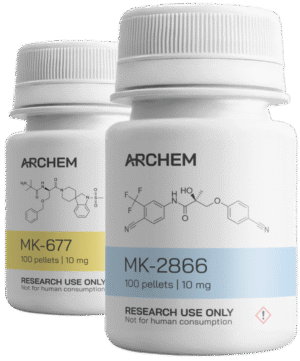
🔍 Introduction: Past the Hype, Into the Research
Ostarine has become a bit of a wildcard in the world of experimental drugs. Some people see it as a possible fix for muscle loss that comes with age, while others think it’s just another promising idea that never quite made it to the finish line. But if we set aside the buzz and actually look at what the clinical trials say, the picture gets a lot clearer.
Let’s walk through the main studies on Ostarine (also known as GTx-024), comparing results, context, and what it could really mean for the people involved.
📊 The Big Three Studies Everyone Talks About
1. Dalton et al., 2011 – Muscle and Strength in Older Adults
Title: SARMs treatment boosts muscle mass and function in healthy older men and postmenopausal women
- Setup: Randomized, double-blind, placebo-controlled
- Length: 12 weeks
- People: 120 adults, age 60+
- Main Focus: Lean body mass, stair climbing power
- Results:
- Lean mass went up by as much as 1.4 kg in the high-dose group
- Notable gains in physical ability
- No serious side effects reported

2. GTx POWER Trials, 2013 – Cancer-Related Muscle Loss
Title: Enobosarm in patients with cancer-related muscle wasting
- Setup: Phase III, placebo-controlled, across multiple centers
- Length: 113 days
- People: Over 300 NSCLC patients
- Main Focus: Muscle mass retention, physical function reported by patients
- Results:
- Treatment group kept more lean muscle
- Physical function improvements were slight and just shy of strong statistical support
- Appetite and general quality of life saw a boost

3. Basaria et al., 2013 – Hormonal and Metabolic Effects
Title: Safety and effects of LGD-4033, with comparison to Ostarine
- Setup: Controlled dose-escalation study
- Length: 21 days
- People: 76 healthy young men
- Focus: Dose effects, testosterone levels, cholesterol changes
- Results:
- Testosterone started dropping at 3 mg/day
- Liver markers stayed mostly stable
- Some changes in lipids, but nothing too worrying
⚖️ Quick Comparison Chart
| Study | Group | Dose | Timeframe | Lean Mass | Function | Side Effects |
|---|---|---|---|---|---|---|
| Dalton et al. (2011) | Older adults | 1–3 mg | 12 weeks | +1.4 kg | Yes | Mild T suppression |
| GTx POWER (2013) | Cancer patients | 1–3 mg | ~16 weeks | Yes | Barely | Appetite up, fatigue |
| Basaria et al. (2013) | Healthy young men | 1–3 mg | 21 days | N/A | N/A | Lipid changes, SHBG ↓ |
🎯 Key Takeaways
What Looks Good
- It consistently helps build or maintain muscle
- Side effects are pretty minimal, even in more fragile groups
- Gains in strength and function can genuinely improve day-to-day life
What’s Still Unclear
- Some studies didn’t hit all their goals, especially on physical function
- Most trials were fairly short—long-term safety is still unknown
- Testosterone suppression, while mild, could need monitoring over time
💭 The Human Angle: It’s Not Just Data
There’s a part of this that doesn’t get talked about enough. In studies involving older adults or people fighting cancer, even a little boost in strength or appetite isn’t just a stat—it’s something that matters. In the Dalton study, folks weren’t trying to bulk up. They just wanted to get around easier, maybe carry their grandkids. That context is huge.
🧬 Who Seems to Benefit the Most?
Here’s a quick look at how different groups responded:
| Group | Muscle Gain | Function Boost | Tolerability |
|---|---|---|---|
| Elderly (60+) | High | Medium–High | Excellent |
| Cancer Patients | Medium | Low–Medium | Good, plus appetite |
| Young Healthy Men | Medium | Not tested | Very Good |
Bottom line: Ostarine works best when there’s something to protect or recover—not just to enhance.
🚫 Why Hasn’t It Been Approved?
Even though the results are promising, Ostarine still hasn’t made it through FDA approval. Why?
- Some trials didn’t fully deliver on physical function goals
- It’s up against long-established treatments like testosterone gels
- Its link to underground “performance enhancement” culture has raised red flags
But just because it’s not approved doesn’t mean it’s useless. Most of the time, the issue is how the data’s presented—not the safety or results.
📌 Final Thoughts: More Than Just Noise
Ostarine may not be a magic pill, but it’s proven to be consistent, relatively safe, and scientifically interesting over the years. And for people dealing with muscle loss—not for vanity, but for everyday living—that consistency matters.
This isn’t about performance enhancement. It’s about helping folks stay mobile, independent, and strong in the face of age or illness. That’s something worth paying attention to.
🔖 Scientific References
- Dalton JT, et al. (2011). Selective androgen receptor modulator treatment improves muscle mass and physical function in healthy older men and postmenopausal women. J Cachexia Sarcopenia Muscle.
- GTx-024 in Cancer Cachexia (NCT01355484) – ClinicalTrials.gov
- Basaria S, et al. (2013). Safety and pharmacokinetics of SARMs. J Clin Endocrinol Metab.
Further Reading : Checking the research on MK677
